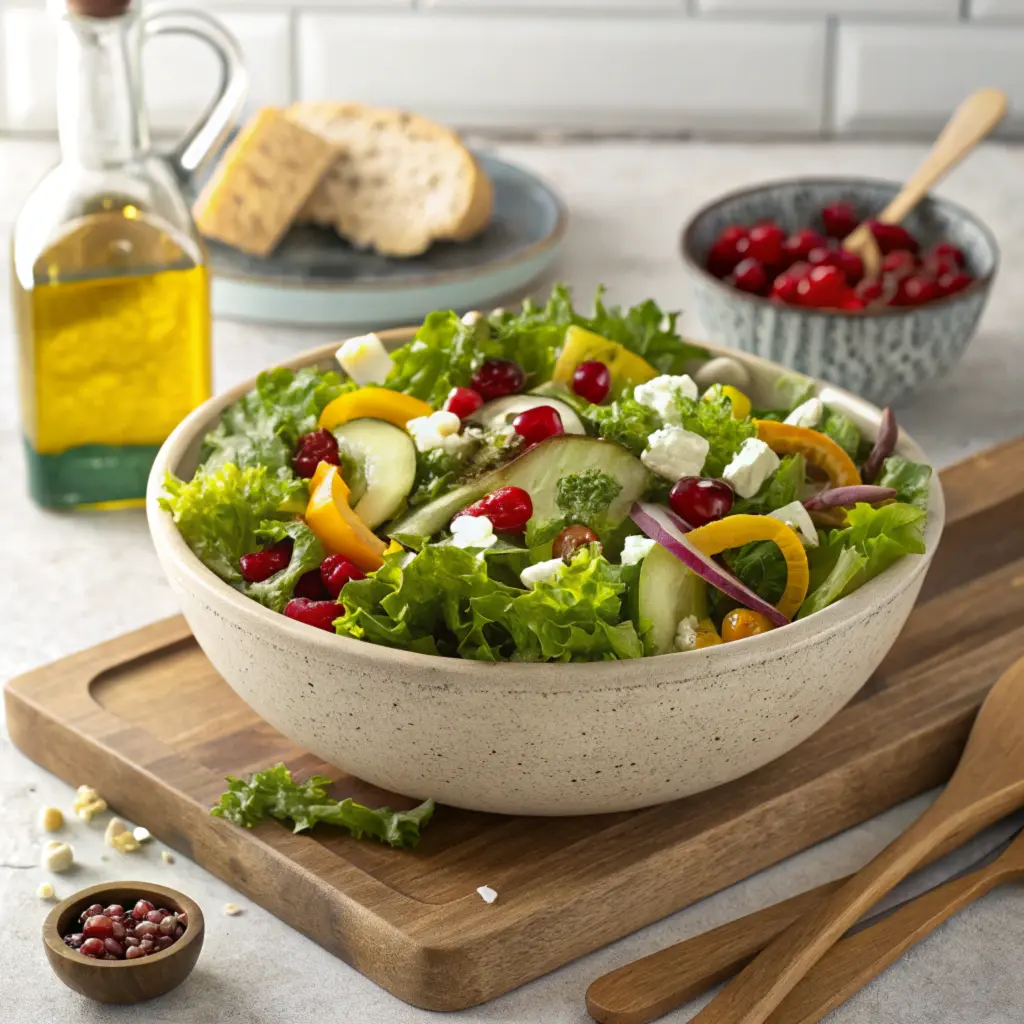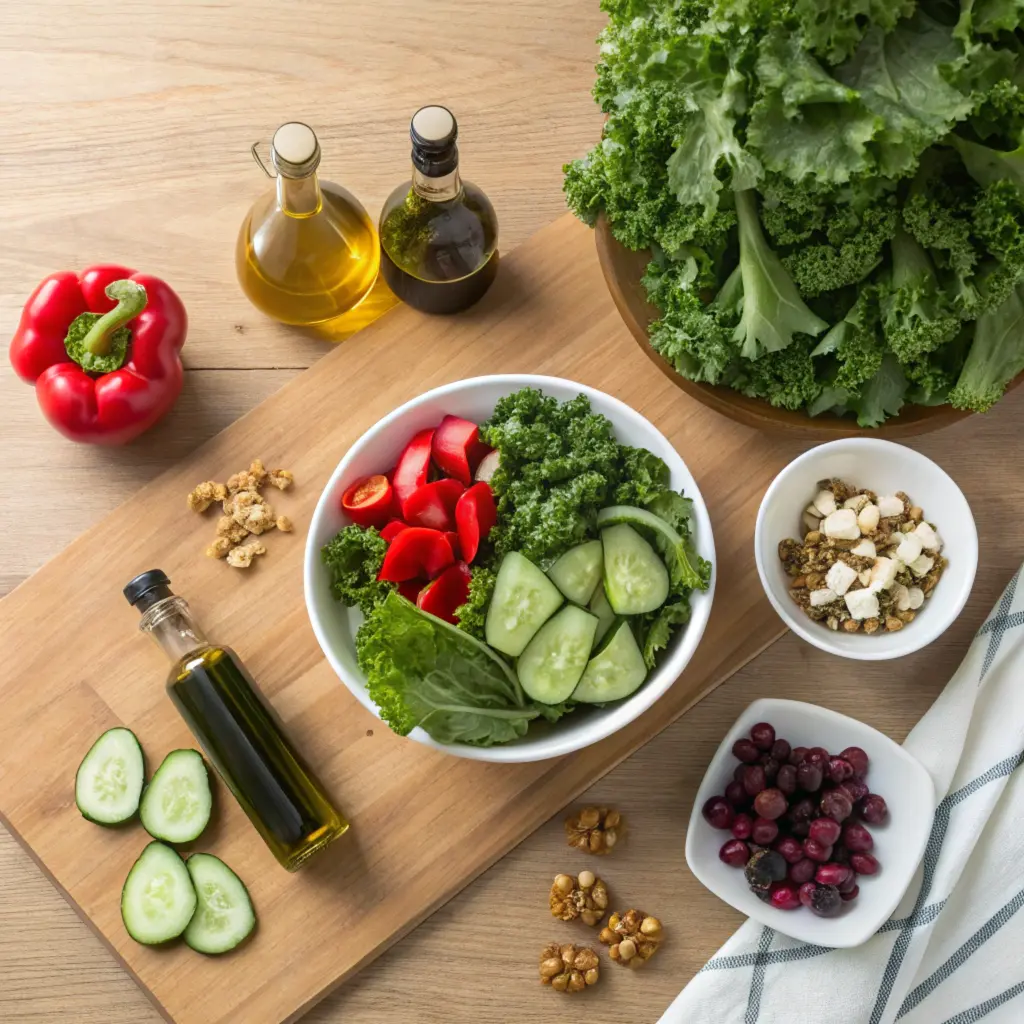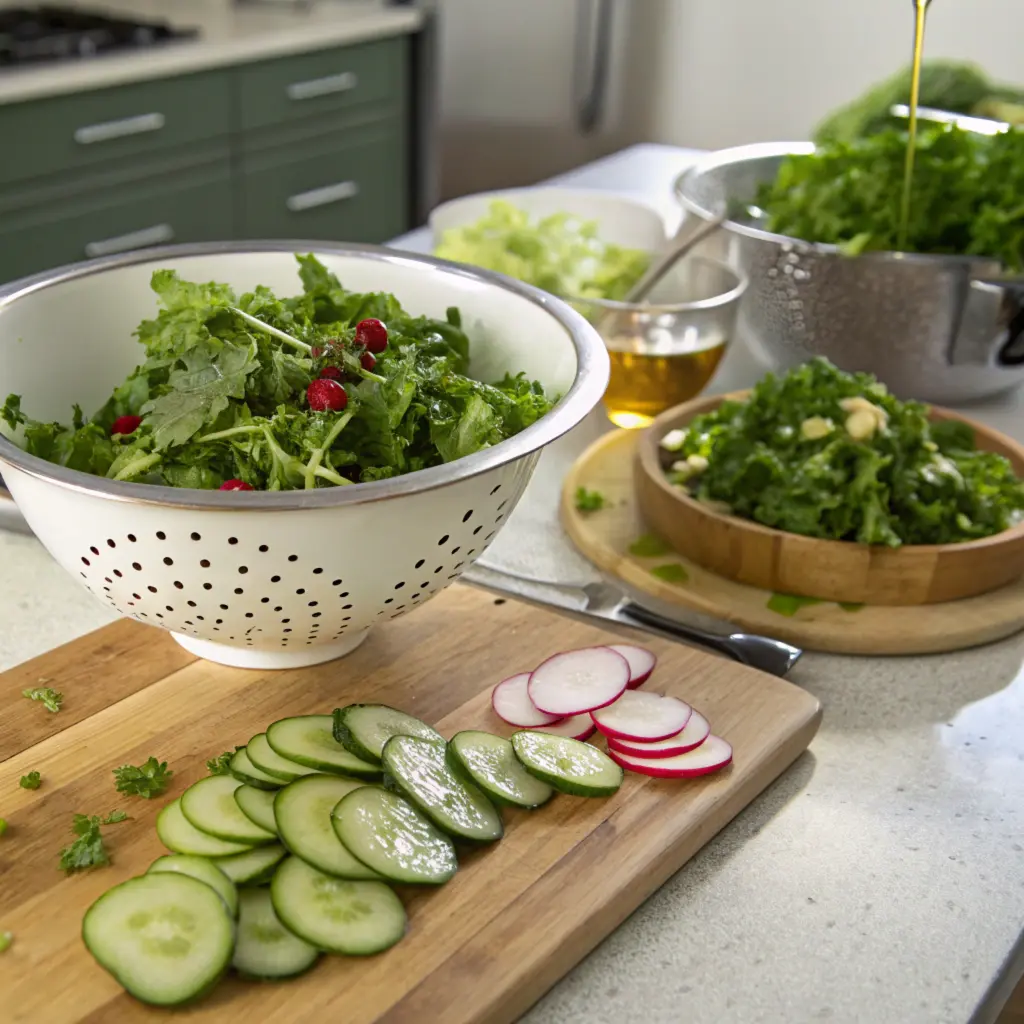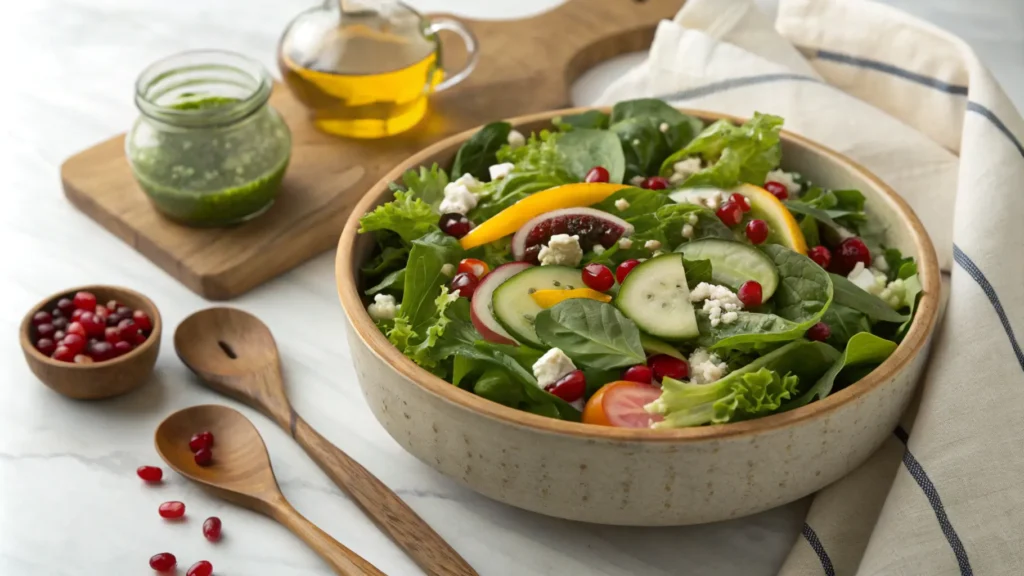Let’s be real. When it comes to making salads, most people think it’s all about tossing some lettuce and calling it a day. But a truly delicious green salad? That takes a little more thought. Don’t worry, though. You don’t need to be a chef, and you won’t need a lot of fancy tools either. If you’re in the mood for something a bit different, check out this recipe for Broccoli Cauliflower Salad, which adds a fun twist to your usual salad lineup. Now, let’s dive into how you can make your salad game strong with simple, everyday steps.

Ingredients for Green Salad
When it comes to ingredients, the beauty of a green salad lies in its simplicity. But simple doesn’t mean boring. You’ll need a good mix of textures and flavors to keep things interesting.
Here’s what you’ll want to grab:
- Leafy greens: Pick from romaine, spinach, kale, or even arugula. The fresher, the better.
- Crunchy extras: Think cucumbers, bell peppers, or radishes. They give that satisfying crunch.
- A touch of sweetness: Add fruits like apple slices, dried cranberries, or some pomegranate seeds.
- Savory bits: Crumbled feta, shredded parmesan, or chopped hard-boiled eggs work well here.
- Nuts or seeds: Sunflower seeds, almonds, or walnuts for extra texture.
- Dressing: A simple olive oil and vinegar combo is perfect, but ranch or balsamic vinaigrette can work too.

Remember to wash and dry your veggies. No one likes a soggy salad.
Tools and Equipment Needed
Let’s keep it basic—no need for anything that’ll sit unused in the back of your cabinet.
- Cutting board: For chopping all those crisp veggies.
- Sharp knife: A dull knife will crush your greens instead of slicing them.
- Salad spinner: If you don’t have one, pat your greens dry with a clean towel.
- Large mixing bowl: Big enough to toss everything without making a mess.
- Tongs or salad hands: Tossing by hand works too, but this keeps things clean.
- A mason jar: Great for shaking up your dressing.
Pro tip: If you’ve ever struggled with unevenly chopped veggies, take your time with that knife. Or grab pre-chopped ones at the store—it’s a time saver and no one will judge.
How to Make Green Salad: Step-by-Step Guide
A green salad is more than just throwing ingredients in a bowl. It’s about layering flavors, textures, and freshness in the right way. Here’s an expanded step-by-step guide to make your salad stand out.
Step 1: Start with the Greens
The greens form the foundation of your salad, so choose wisely. Some tips for this step:
- Pick your greens: Romaine for crunch, spinach for softness, or a mix of arugula and kale for peppery and hearty flavors.
- Wash thoroughly: Even pre-washed greens can benefit from a rinse to confirm they’re fresh.
- Dry well: Use a salad spinner or pat them with a clean kitchen towel. Wet greens make dressing slide off and result in a soggy salad.
- Tear instead of chop: Tearing keeps the greens’ natural edges intact, which helps hold dressing better.
Step 2: Add Layers of Flavor
This is where your creativity comes in. Adding variety keeps your green salad interesting and flavorful.
- Crunchy veggies: Slice cucumbers thin, dice bell peppers, or shave radishes for some bite.
- Savory bites: Add crumbled cheeses like feta, blue cheese, or shredded cheddar. Protein options like grilled chicken or boiled eggs also fit in here.
- Something tangy: Olives, pickled onions, or a splash of lemon juice brighten up the flavors.
Layer each ingredient evenly to prevent one flavor from overpowering the others.
Step 3: Don’t Skimp on Texture
Texture is what separates a good salad from a great one. Add something crunchy or creamy:
- Nuts or seeds: Toasted almonds, sunflower seeds, or pumpkin seeds add a satisfying crunch.
- Crunchy extras: Croutons, crispy chickpeas, or even tortilla strips for added texture.
- Creamy elements: Avocado slices or a dollop of hummus can balance out the crunch with smoothness.
Spread these ingredients throughout the salad so every bite has a bit of everything.
Step 4: Finish with Fruit
Adding fruit gives your green salad a burst of sweetness and freshness:
- Seasonal picks: Strawberries, blueberries, or oranges work well in summer. Apples, pears, or dried cranberries are great in cooler months.
- Cut properly: Small, even slices or chunks confirm the fruit is easy to eat.
- Balance the flavors: Pair sweet fruits with tangy dressings or savory toppings to keep the salad balanced.
Sprinkle the fruit on top to keep it from getting lost under heavier ingredients.
Step 5: Make the Dressing
A homemade dressing improves your salad without much effort. Here’s an easy recipe:
- Basic ingredients: Combine 3 parts olive oil to 1 part vinegar (balsamic, red wine, or apple cider all work).
- Add some sweetness: A dash of honey or a pinch of sugar balances out the tang.
- Season well: Salt, pepper, and a little Dijon mustard bring everything together.
- Shake it up: Use a mason jar or small bowl to whisk or shake the dressing until it’s emulsified.
Pro tip: Taste as you go. Adjust the seasoning to match the salad’s ingredients.
Step 6: Toss It Right
The final step is where it all comes together:
- Add dressing last: Pour it over the salad just before serving to keep everything crisp.
- Toss gently: Use tongs or salad hands to mix without bruising the greens. Over-tossing can break down delicate leaves.
- Adjust portions: If serving family-style, keep extra dressing on the side so everyone can add more if they want.

Bonus Tips:
- Serve immediately: Freshly tossed salads are always the best.
- Keep it simple: Focus on balancing a few great ingredients instead of overwhelming the salad with too many elements.
- Taste test: Before serving, try a small bite to confirm the flavors are balanced.
With these detailed steps, you’ll create a green salad that’s fresh, flavorful, and worth going back for seconds.
Tips for Green Salad
- Keep it fresh. Store your greens in an airtight container with a paper towel to absorb moisture.
- Dress to impress. Always add dressing right before eating. This keeps your salad crisp.
- Mix textures. Combine something creamy (like cheese), something crunchy (nuts), and something tangy (vinegar or citrus).
- Go seasonal. Use what’s fresh and in season. Winter? Go for oranges. Summer? Berries are your best bet.
- Pre-chop wisely. If you’re making salad ahead, keep your wet ingredients (like cucumbers) separate until you’re ready to eat.
Variations of Green Salad
Salads don’t have to be predictable. Switch it up based on your mood, pantry, or dinner theme.
Classic Caesar Twist
- Skip the kale and stick with romaine.
- Add croutons, parmesan, and Caesar dressing.
- A squeeze of lemon goes a long way.
Sweet and Savory
- Greens, candied walnuts, goat cheese, and sliced pears.
- Top with a drizzle of honey vinaigrette.
Protein-Packed
- Toss in grilled chicken, boiled eggs, or chickpeas.
- Avocado slices add creaminess without the cheese.
Mediterranean Vibes
- Add olives, feta, tomatoes, and red onions.
- A splash of lemon juice and oregano takes it to the next level.
Taco Salad
- Swap romaine for a mix of greens.
- Add black beans, corn, shredded cheese, and crushed tortilla chips.
- Finish with a dollop of salsa and sour cream.
Nutritional Benefits of Green Salad
When you pile your plate with fresh greens, you’re doing more than just eating healthy. Salads are packed with vitamins, minerals, and fiber.
- Greens like spinach and kale: Loaded with iron and vitamin K, they support bone health and energy levels.
- Crisp veggies like cucumbers and carrots: High in water content, they keep you hydrated and full.
- Nuts and seeds: Provide healthy fats and protein for long-lasting energy.
- Homemade dressings: Olive oil-based dressings add a dose of omega-3s.
Eating a green salad before meals can even help control portions. The fiber fills you up, so you’re less likely to overeat. Small changes like these add up quickly.
Storage and Reheating Tips for Green Salad
Nobody wants to pull a limp, soggy salad out of the fridge. To keep your salad fresh:
- Store dressing separately. Adding it too soon will wilt the greens.
- Layer smartly. Put the heartier ingredients like cucumbers and carrots at the bottom of the container. Greens go on top.
- Use an airtight container. Keeps everything crisp and prevents any weird fridge smells.
If you’ve made a large batch, only dress what you’re eating. Leftovers can last up to 2-3 days in the fridge when stored right. Avoid reheating salads with fresh greens—they’re meant to be enjoyed cold or at room temperature.
Serving Suggestions for Green Salad
A green salad doesn’t have to be a lonely side dish. With a few tweaks, it can shine as a main course or complement any meal.
- Pair it with grilled chicken or salmon for a quick lunch.
- Serve alongside pasta for a lighter, refreshing balance.
- Add a slice of garlic bread or a baked potato for a hearty dinner option.
- For parties, make a big bowl with a mix of greens, colorful veggies, and a crowd-pleasing dressing like ranch or balsamic.
You can also prep individual portions in mason jars. These are perfect for grab-and-go lunches that still taste fresh.
FAQs
What is a green salad made of?
A basic green salad typically includes fresh leafy greens like spinach, lettuce, or arugula, along with toppings like cucumbers, tomatoes, and maybe a sprinkle of cheese or nuts. Dress it up with your favorite dressing.
What is green salad commonly known as?
People often call it a “garden salad” or “mixed greens salad,” but the idea is the same: fresh, simple, and customizable.
What is the most popular salad green?
Romaine lettuce often takes the crown for its crunch and versatility. Spinach is also a favorite for its mild flavor and nutrient-packed profile.
What are the 5 basic types of salads?
Green salads (like Caesar or garden salads).
Fruit salads.
Grain-based salads (think quinoa or farro).
Protein-packed salads (like chicken or tuna salad).
Mixed salads that combine greens, proteins, and carbs for a complete meal.
A Beginner’s Guide to Green Salad
If you’re just starting, keep it simple. A basic salad with three to five ingredients is all you need.
- Choose your greens—romaine for crunch, spinach for softness.
- Add one crunchy veggie, like cucumbers.
- Toss in a protein like boiled eggs or grilled chicken.
- Pick a dressing. Store-bought is fine when you’re in a pinch.
- Taste and tweak. Need salt? A splash of lemon? Experiment a little.
Making salads can be quick, fun, and mess-free with the right prep.
Advanced Tips for Green Salad Enthusiasts
Ready to up your salad game? These tips are for you:
- Massage kale. A little olive oil and a quick rub-down make it less bitter and easier to chew.
- Make your own croutons. Use stale bread, olive oil, and seasonings, then bake until crispy.
- Try unusual greens. Mizuna, frisée, or pea shoots add variety and flavor.
- Layer textures. Combine creamy avocado, crunchy seeds, and juicy fruits like oranges or berries.
- Use herbs. Fresh parsley, cilantro, or dill can transform a plain salad into something extraordinary.
Experiment with different dressings and toppings to keep things fresh and exciting.
The Appeal of Green Salad
Why do so many people love green salad? It’s not just about the health benefits. Salads are:
- Versatile. They work as a meal, snack, or side.
- Customizable. Add what you like, skip what you don’t.
- Budget-friendly. Seasonal produce can save you money.
- Quick to make. With a little prep, you can throw one together in under 10 minutes.
Plus, a good salad can be surprisingly satisfying. With the right mix of flavors and textures, it never feels like a chore to eat.
Homemade vs. Store-Bought Green Salad
Sure, grabbing a pre-packaged salad from the store is convenient, but homemade wins every time. Here’s why:
- Freshness. Store salads often wilt quickly, especially if they’ve been sitting for a while.
- Control. You choose what goes in—no mystery ingredients or preservatives.
- Cost. Pre-made salads can add up fast. Making your own is cheaper in the long run.
If you’re short on time, pre-washed greens can save a step. But homemade dressing and fresh toppings are worth the effort.
Conclusion
A green salad doesn’t have to be boring or complicated. With a mix of fresh ingredients, a little creativity, and some simple prep tips, you can turn salads into a meal you actually crave. Whether you’re keeping it basic or trying new flavors, salads are a tasty, healthy addition to any table.


